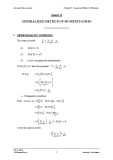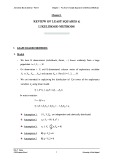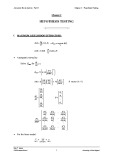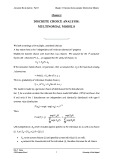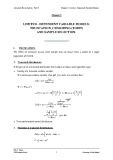
Lecture Advanced Econometrics
-
Lecture "Advanced Econometrics (Part II) - Chapter 13: Generalized method of moments (GMM)" presentation of content: Orthogonality condition, method of moments, generalized method of moments, GMM and other estimators in the linear models, the advantages of GMM estimator, GMM estimation procedure.
 9p
9p  nghe123
nghe123
 06-05-2016
06-05-2016
 96
96
 5
5
 Download
Download
-
Lecture "Advanced Econometrics (Part II) - Chapter 3: Discrete choice analysis - Binary outcome models" presentation of content: Discrete choice model, basic types of discrete values, the probability models, estimation and inference in binary choice model, binary choice models for panel data.
 18p
18p  nghe123
nghe123
 06-05-2016
06-05-2016
 67
67
 6
6
 Download
Download
-
Lecture "Advanced Econometrics (Part II) - Chapter 1: Review of least squares & likelihood methods" presentation of content: Least quares methods, maximum likelihood estimation.
 6p
6p  nghe123
nghe123
 06-05-2016
06-05-2016
 68
68
 3
3
 Download
Download
-
Lecture "Advanced Econometrics (Part II) - Chapter 2: Hypothesis testing" presentation of content: Maximum likelihood estimators, wald test, likelihood ratio test, lagrange multiplier test, application of tests procedures to linear models, hausman specification test, power and size of tests.
 7p
7p  nghe123
nghe123
 06-05-2016
06-05-2016
 57
57
 3
3
 Download
Download
-
Lecture "Advanced Econometrics (Part II) - Chapter 4: Discrete choice analysis - Multinomial models" presentation of content: The multinomial logit model, conditional logit model, mixed logit mode, independence of irrelevant alternatives, nested logit model, multinomial probit model.
 13p
13p  nghe123
nghe123
 06-05-2016
06-05-2016
 78
78
 4
4
 Download
Download
-
Lecture "Advanced Econometrics (Part II) - Chapter 5: Limited dependent variable models - Truncation, censoring (tobit) and sample selection" presentation of content: Truncation, censored data, some issues in specification, sample selection model, regression analysis of treatment effects.
 13p
13p  nghe123
nghe123
 06-05-2016
06-05-2016
 62
62
 4
4
 Download
Download
-
Lecture "Advanced Econometrics (Part II) - Chapter 6: Models for count data" presentation of content: Poisson regression model, goodness of fit, overdispersion, negative binomial regression model, too many zeros data.
 7p
7p  nghe123
nghe123
 06-05-2016
06-05-2016
 86
86
 4
4
 Download
Download
-
Unemployment (or joblessness), as defined by the International Labour Organization, occurs when people are without jobs and they have actively sought work within the past four weeks.[1] The unemployment rate is a measure of the prevalence of unemployment and it is calculated as a percentage by dividing the number of unemployed individuals by all individuals currently in the labor force. During periods of recession, an economy usually experiences a relatively high unemployment rate.
 20p
20p  nhatro75
nhatro75
 09-07-2012
09-07-2012
 90
90
 5
5
 Download
Download
CHỦ ĐỀ BẠN MUỐN TÌM









